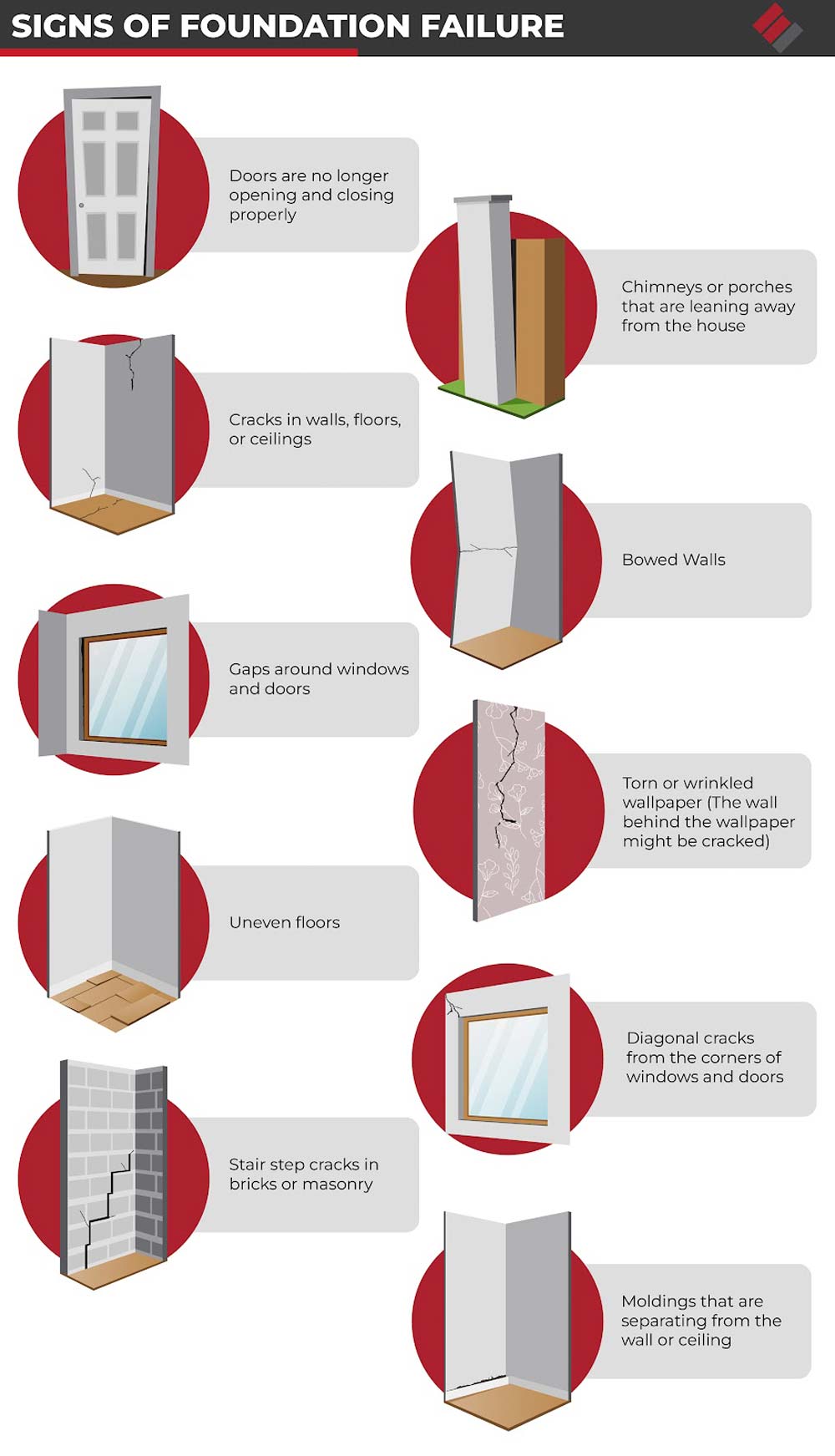Searching for information about foundation replacement? If so, don’t hit that back button because you’ve landed on the right page. In this article, we’ll review foundation replacement, when it’s necessary, how it’s performed, and more.
The Good News: Most Foundations Can Be Repaired

The good news is that most foundation problems can be fixed using various innovative and advanced solutions. Rarely does a foundation need to be replaced. The key is spotting foundation issues early and addressing them promptly before they turn into big problems that will be expensive to fix.
If you suspect your foundation has a problem, it’s crucial to consult a professional foundation repair contractor right away. Timely intervention can protect your home and your wallet.
Common Foundation Repair Techniques
Three common foundation repair solutions include underpinning using push, helical, slab, and drilled concrete piers.
Push Piers
Resistance push piers are steel pipes driven into the ground using hydraulic pressure and the building’s weight. They’re designed to transfer the weight of a structure from unstable soil to deep, stable soil or bedrock.

Helical Piers
Helical piers, which resemble giant corkscrews, are turned into the ground until they reach load-bearing soil. Once in place, a synchronized hydraulic lifting system raises the foundation to maximum practical level or as much as possible without causing damage.
Slab Piers
Slab piers are push or helical piers installed through holes drilled in the slab.
Drilled Concrete Piers
Drilled concrete piers are a common repair solution for homes built on hillsides that are experiencing lateral movement. (Epp Foundation Repair does not install drilled concrete piers.)
What Is Foundation Replacement?
Foundation replacement is a complex construction process that involves completely removing the old foundation of a building or structure and building a new one in its place. This process is necessary when the existing foundation is structurally unsound, damaged by natural occurrences such as soil erosion, or no longer meets local building codes and regulations.
When Is Foundation Replacement Necessary?
One of the most important factors in determining whether foundation replacement is necessary is the extent of the damage. If the damage is extensive, replacement is often the best option.
Another factor that can impact whether foundation replacement is the best choice is the age of the foundation. Significant wear and tear may have accumulated over the years if the foundation is quite old. This can result in cracks that extend deep into the foundation or even crumbling in some instances.
For more information, check out our blog about – Slab foundation vs crawl space.
How Is Foundation Replacement Done?
Foundation replacement is an intricate and costly process that requires a high level of expertise and precision. The process typically involves several key steps, including site preparation, excavation, removal of the old foundation, and creating a new one.

Step 1: Assessment
Before beginning the foundation replacement process, the site must first be assessed by a qualified foundation repair contractor to determine the existing foundation's structural integrity and identify any potential concerns or safety hazards. This assessment will also help determine the materials and equipment needed to complete the project. In some cases, the entire foundation may need to be removed, while in others, only certain sections may need to be replaced.

Step 2: Site Preparation
Once the assessment is complete, the site is prepared by removing any obstacles or debris that may interfere with the excavation and foundation construction process.

Step 3: Excavation to Remove the Old Foundation
Excavation is then carried out using heavy equipment such as backhoes and jackhammers to remove the old foundation.

Step 4: Construction of the New Foundation
After the old foundation is removed, the new foundation is then constructed. This involves creating a new foundation slab, footings, and walls, depending on the type of foundation required for the specific structure. The new foundation must be constructed to meet the local building codes and regulations and must also be designed to withstand the structural load of the building or structure.
How Much Does It Cost to Replace a Foundation?
The cost of a foundation replacement can vary depending on a wide range of factors, including the size and type of home, the extent of damage to the existing foundation, and the necessary foundation materials and techniques.
Typically, the cost of foundation replacement can range from several thousand to tens of thousands of dollars. This price range includes the cost of hiring professionals to excavate the site, remove the existing foundation, and install the new foundation.
The materials used during the replacement process also play a significant role in determining the cost. Concrete is likely to be the most common material used to build a new foundation, and the cost of this material can vary based on its quality and availability.
In addition to the above factors, the cost of foundation replacement may be influenced by local building codes, permits, and inspections. Other factors that may impact the cost include difficulty accessing the site and any additional repairs or upgrades that may be required during the replacement process.
Common Signs of Foundation Damage
As noted above, most foundation problems can be fixed. Therefore, it’s crucial to catch foundation problems as early as possible while they cost less to repair. Here are some common signs your home’s foundation might have a problem:
- Cracks in walls, floors, and ceilings. These cracks can occur both inside and outside.
- Torn wallpaper. This could indicate the wall behind the wallpaper is cracked.
- Doors and windows that are difficult to open or close
- Uneven floors
- Diagonal cracks from the corners of doors and windows
- Ceilings and floors that are separating from the wall
- Stair step cracks in brick or masonry
- Chimneys and porches that are pulling away from the house

If you’re concerned your home might need foundation replacement, contact us today and schedule a foundation evaluation. We serve areas in four states: Nebraska, Iowa, Kansas, and Missouri.







